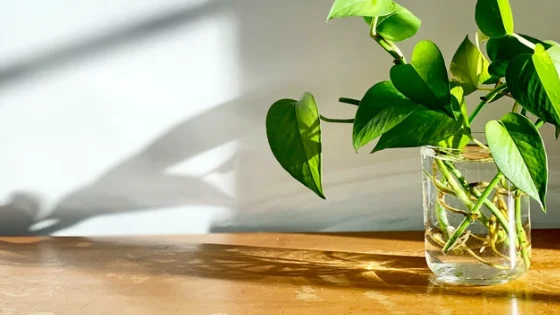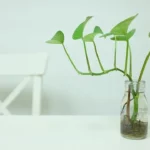Plants such as pothos do not tolerate a lot of direct sunshine shining directly on their leaves. If you have a south-facing window, relocate the plant to the side or several feet away from the window if feasible. The neon is better able to withstand higher levels of light than the other Pothos types.
Table of Contents
What’s the Best Place to Place Pothos in My Home?
Beginners will find Pothos easy to care for since they are tropical plants. They have self-supporting vines. They may be put in any of your preferred locations since they can withstand a variety of environmental situations.
However, completely disregarding their demands might cause them to suffer, resulting in yellow leaves, drooping leaves, brown foliage, and other symptoms. Therefore, proper positioning is critical.
Pothos may be maintained in workplaces, bathrooms, dining areas, and other public areas. Make an effort to place them in the most central portion of your home. However, they may suffer in direct and harsh light, which is why they perform best in moderate light circumstances. The trick is to keep it out of direct sunshine. Depending on your preference, you may either put them in soil or water.
If you are properly watering and feeding your plants, but they are still suffering, you might determine that you have placed them incorrectly.
You may find the best location for your pothos by reading on.
Read More: Is misting good for pothos?
Where should I put my pothos?
Pothos may be put in a variety of locations. Here are a few of the more typical locations that you could come upon.
Close to a window
Place your pothos near a window to encourage it to grow more prolifically.
A sufficient amount of brilliant light will filter in via the window, promoting the development of your plant. The glass will screen the blazing sunlight, reducing its intensity to a level that is ideal for growing your plant.
If you believe the intensity of the light is too great, move your pothos a few feet away from the window to avoid sunburn or brown patches on the leaves. This will also prevent the soil from drying up as fast as possible.
Generally speaking, the intensity is modest during the winter, but the glass of the windows is damp and freezing. During this period, keep your pothos away from the window; otherwise, the leaves that come into contact with the glass may dry up and acquire brown stains.
While positioning your pothos, keep the window’s orientation in mind. The amount of light entering your area should be sufficient to illuminate your room and your plant.
Read More: How Often to water pothos in winter?
Away from children
Every pothos grower, particularly those with children, should be aware that the plant is harmful to people. These may be dangerous if consumed by adults and children alike.
They contain a toxin called calcium oxalate, which may cause mouth, tongue, and lip irritation, swelling, and inflammation. They may also cause eczema as a side effect of being bitten, as well as skin irritation if they are encountered repeatedly and in large quantities.
So, you should always keep your potos away from your child. It will also help you avoid stress.
Keeping pets away
Who doesn’t like having pets and plants as part of their daily lives and growing up with them? However, when you have pets such as dogs or cats in the house, you must exercise particular caution with some plants.
It has been discovered that pothos contain insoluble raphides and calcium oxalate, both of which are very harmful to pets.
They have the potential to induce vomiting, trouble swallowing, and mouth discomfort. In the event that your dogs have swallowed anything on them, you should call your veterinarian as soon as possible.
Read More: How Do I Know If My Pothos Needs Water?
Placement near a fireplace should be avoided.
Never set your pothos near a fireplace; since they are combustible things, they have the potential to catch fire without your knowledge. Those flying sparks have the potential to cause a little burn to your plant leaves.
Because pothos thrive in humid environments, they will soon take all of the moisture from your plant, causing it to get sick from the inside out. Brown patches, drooping leaves, a sickly plant, yellow foliage, and stalled growth are all signs of a disease that will manifest itself over time.
It’s never a good idea to keep pothos near a fire. Pothos are unable to handle the heat, and they do not like being in such high temperatures. Their leaves will begin to droop and eventually perish. Pothos may even perish if exposed to excessive heat.
If you still want to keep your pothos near a fireplace, choose a location where your plant will not be affected by the heat from the fire by putting your hands in front of your plant and feeling the intensity of the heat radiating from it.
Read More: Can You Propagate Pothos Without Node?
The room’s temperature
Pothos may grow in a broad range of environmental circumstances that you give, but they function best at temperatures ranging from 65 degrees Fahrenheit to 85 degrees Fahrenheit, depending on the kind of soil you use.
It is still OK to place your plant in an area where the temperature is lower than the above-recommended range, but temperatures below 50 degrees Fahrenheit may be fatal.
If you reside in a colder climate, it is best not to plant them since they will not survive the winter.
Keep them away from openings or vents, as well as from direct sunlight, to prevent any problems with growth and dryness.
Bedroom with Pothos
An arrangement of pothos may be a lovely touch to your bedroom. They accompany you, providing a sight of nature in the comfort of your own home. It also has the additional benefit of purifying the air and being soothing for the senses.
According to research, pothos or any other plant suffers from a decrease in oxygen production at night owing to a lack of sunshine and instead produces carbon dioxide, which seems to be detrimental.
However, it is said that as long as the room is sufficiently aired and does not include a large number of plants, you may keep them in your bedroom without concern.
Keep your pothos away from the air conditioning unit. The dry, chilly air from the air conditioner will lower the humidity levels in the air, allowing the soil to dry out more quickly.
Additionally, placing them in a location that is exposed to strong light but is hidden by windows or curtains is ideal.
If you want them close to you, place them near the lamp, which should provide indirect light that is not too strong.
Attention: If you have any respiratory problems, you should avoid these plants to be on the safe side.
Read More: Can You Put Pothos In Front Of A Window?
The use of pothos in the bathroom
It’s easy to add a pothos plant to your bathroom decor, and it will look great.
They don’t need a lot of light. Pothos may survive in low humidity as well, although they prefer the additional moisture provided by bathrooms.
Pothos thrives in warm, humid environments, such as those found in bathrooms. Because you will be visiting them on a regular basis, you will be able to readily water them without forgetting.
They’ll clean the air in your bathroom and look great on the counter or hung near a window.
Some pointers on where to put your pothos

- Keep it simple and don’t worry too much about where to place your pothos.
- It is in bright filtered light that pothos grow, therefore make sure they are exposed to strong light for around 10-12 hours every day.
- Use a humidifier to keep the humidity levels in the air at a moderate to high level.
- Use a slightly wet towel to wipe the leaves of their plants to eliminate dust, let the leaves absorb moisture, and aid in the photosynthesis process.
- Pothos with variegated leaves need more light to maintain their color and variegation, thus they should be placed in a more exposed location.
- Pothos are tough and difficult to break down, but if they are left in colder climates for an extended period of time, they will suffer.
- Their leaves will initially exhibit indications of life in the form of drooping, yellow leaves, which will eventually lead to their demise.
- Trim the length using sterilized scissors to keep it under control and in check.



